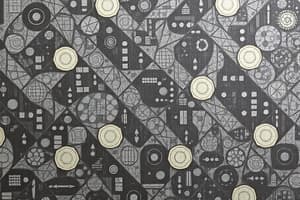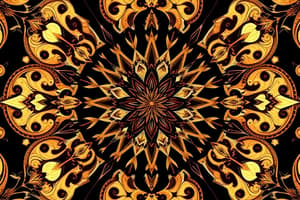Podcast
Questions and Answers
___________ sequences reflect the pattern in nature found in flowers like sunflowers, pine cones, and even the spiral arrangement of seeds inside some fruits.
___________ sequences reflect the pattern in nature found in flowers like sunflowers, pine cones, and even the spiral arrangement of seeds inside some fruits.
Fibonacci
Another well-known pattern in math is the simple recurrence relation x_{n+1} = ax_n + __.
Another well-known pattern in math is the simple recurrence relation x_{n+1} = ax_n + __.
b
Our brains excel at recognizing and analyzing visual patterns, a skill that has been adapted for computer vision applications via ____________ algorithms.
Our brains excel at recognizing and analyzing visual patterns, a skill that has been adapted for computer vision applications via ____________ algorithms.
machine learning
____________ reveal underlying structures and relationships between numbers or other entities.
____________ reveal underlying structures and relationships between numbers or other entities.
Patterns are visible everywhere, from the repetitive stripes of a tiger's fur to the symmetrical arrangement of branches in a _____________.
Patterns are visible everywhere, from the repetitive stripes of a tiger's fur to the symmetrical arrangement of branches in a _____________.
In the exploration of patterns, we will dive into various aspects, including their presence within mathematics, recognition through machine learning, beauty across geometry, and ____________ patterns intentionally.
In the exploration of patterns, we will dive into various aspects, including their presence within mathematics, recognition through machine learning, beauty across geometry, and ____________ patterns intentionally.
By training models on extensive datasets containing labeled examples of specific patterns, computers can learn to identify these patterns in new images and videos. Examples include detecting faces, classifying objects, and interpreting ______ signs.
By training models on extensive datasets containing labeled examples of specific patterns, computers can learn to identify these patterns in new images and videos. Examples include detecting faces, classifying objects, and interpreting ______ signs.
Geometrical patterns are all around us, from the tilings used in mosaic art to the crystalline structure of snowflakes and minerals. Tessellations like Penrose tiles and Escher's famous lithographs defy intuition yet remain organized and structured. Other geometrical patterns commonly appear as spirals, circles, squares, rectangles, ______, often arranged symmetrically or following fractal principles.
Geometrical patterns are all around us, from the tilings used in mosaic art to the crystalline structure of snowflakes and minerals. Tessellations like Penrose tiles and Escher's famous lithographs defy intuition yet remain organized and structured. Other geometrical patterns commonly appear as spirals, circles, squares, rectangles, ______, often arranged symmetrically or following fractal principles.
Repeating patterns occur when elements repeat according to a set order, such as bricks on a wall or letters forming ______. Repetition emphasizes symmetry and brings rhythm to visual compositions.
Repeating patterns occur when elements repeat according to a set order, such as bricks on a wall or letters forming ______. Repetition emphasizes symmetry and brings rhythm to visual compositions.
To create exciting patterns, artists must combine artistic creativity with knowledge of fundamental rules like rhythm, scale, proportion, contrast, harmony, and unity. Understanding how to work effectively with patterns means considering color choices, element placement, iterations, and variations. Exploring different techniques such as drawing, painting, printing, and digital design allows creators to experiment with patterns and expand their ______.
To create exciting patterns, artists must combine artistic creativity with knowledge of fundamental rules like rhythm, scale, proportion, contrast, harmony, and unity. Understanding how to work effectively with patterns means considering color choices, element placement, iterations, and variations. Exploring different techniques such as drawing, painting, printing, and digital design allows creators to experiment with patterns and expand their ______.
Their distinctive character makes them popular both aesthetically and ______.
Their distinctive character makes them popular both aesthetically and ______.
Balance repeated patterns carefully while designing engaging works to avoid monotony and lack of ______.
Balance repeated patterns carefully while designing engaging works to avoid monotony and lack of ______.
Flashcards
What are patterns?
What are patterns?
Ordered arrangements of numbers, shapes, or other elements that follow a specific rule or sequence.
Fibonacci Sequence
Fibonacci Sequence
A sequence where each number is the sum of the two preceding ones (e.g., 1, 1, 2, 3, 5, 8...).
Recurrence Relation
Recurrence Relation
A mathematical relationship defining growth or decay without variation, often seen in population dynamics or radioactive decay.
Pattern Recognition
Pattern Recognition
Signup and view all the flashcards
Geometric Patterns
Geometric Patterns
Signup and view all the flashcards
Repeating Patterns
Repeating Patterns
Signup and view all the flashcards
Artistic Principles
Artistic Principles
Signup and view all the flashcards
Pattern Design Elements
Pattern Design Elements
Signup and view all the flashcards
Pattern Creation Techniques
Pattern Creation Techniques
Signup and view all the flashcards
Study Notes
Patterns: From Mathematical Insights to Visual Artistry
Patterns have captivated our minds since ancient times. They're visible everywhere—from the repetitive stripes of a tiger's fur to the symmetrical arrangement of branches in a tree. In this exploration, we will dive into various aspects of patterns, including their presence within mathematics, recognition through machine learning, beauty across geometry, and crafting patterns intentionally.
Mathematical Patterns
Mathematicians treasure patterns because they reveal underlying structures and relationships between numbers or other entities. For example, take Fibonacci sequences where every number equals the sum of the two preceding ones – starting with 1, 1, 2, 3, 5, 8... Each subsequent term is calculated by adding the previous two terms. These sequences reflect the pattern in nature found in flowers like sunflowers, pine cones, and even the spiral arrangement of seeds inside some fruits.
Another well-known pattern in math is the simple recurrence relation (x_{n+1} = ax_n + b), which beautifully demonstrates growth without decay or spontaneous variation. It shows up in phenomena such as population dynamics, radioactive decay, and sound echoes from multiple surfaces.
Pattern Recognition
Our brains excel at recognizing and analyzing visual patterns. This skill has been adapted for computer vision applications via machine learning algorithms. By training models on extensive datasets containing labeled examples of specific patterns, computers can learn to identify these patterns in new images and videos. Examples include detecting faces, classifying objects, and interpreting traffic signs.
Geometric Patterns
Geometrical patterns are all around us, from the tilings used in mosaic art to the crystalline structure of snowflakes and minerals. Tessellations like Penrose tiles and Escher's famous lithographs defy intuition yet remain organized and structured. Other geometrical patterns commonly appear as spirals, circles, squares, rectangles, triangles, etc., often arranged symmetrically or following fractal principles. Their distinctive character makes them popular both aesthetically and mathematically.
Repeating Patterns
Repeated patterns occur when elements repeat according to a set order, such as bricks on a wall or letters forming text. Repetition emphasizes symmetry and brings rhythm to visual compositions. However, excessive repetition may result in monotony and lack of variety. Therefore, it's essential to balance repeated patterns carefully while designing engaging works.
Creating Patterns
To create exciting patterns, artists must combine artistic creativity with knowledge of fundamental rules like rhythm, scale, proportion, contrast, harmony, and unity. Understanding how to work effectively with patterns means considering color choices, element placement, iterations, and variations. Exploring different techniques such as drawing, painting, printing, and digital design allows creators to experiment with patterns and expand their skills.
Studying That Suits You
Use AI to generate personalized quizzes and flashcards to suit your learning preferences.




